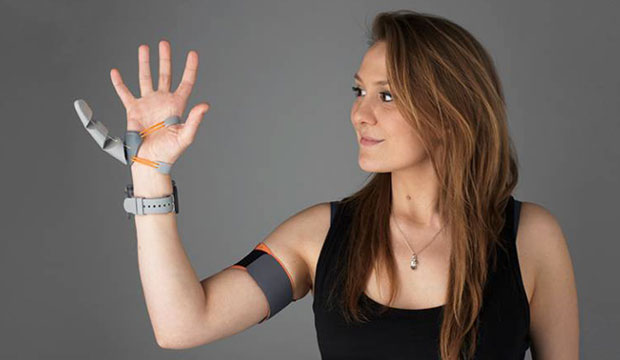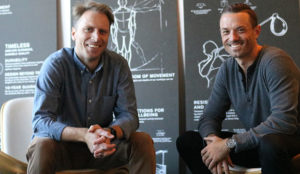Researchers at the University College London are giving new meaning to the expression “all thumbs.”
They’ve taken an award-winning graduate project from the Royal College of Art in London and are using it to test the brain’s reaction to coping with additional body parts.
The idea behind the College of Art project was to reframe traditional views of prosthetics through the use of a robotic thumb that can be attached to a hand.
“Our study shows that people can quickly learn to control an augmentation device and use it for their benefit, without overthinking,” Dani Clode (pictured above), the designer of the robo thumb and a member of the UCL research team investigating how the brain adapts to body augmentation, said in a statement.
“We saw that while using the Third Thumb, people changed their natural hand movements, and they also reported that the robotic thumb felt like part of their own body.”
If having two thumbs is good, then is having three thumbs better? Not necessarily, maintained Howie Choset, co-director of the Biorobotics Lab at Carnegie Mellon University in Pittsburgh.
“Our thumbs aren’t just components,” he told TechNewsWorld. “They’re part of a system.”
“Having an extra thumb doesn’t mean anything,” he said. “It depends on how that thumb works in the context of the new system.”
Toe-Controlled Thumb
For their experiment, the team trained 30 people to use the robo thumb and found the participants could perform a variety of tasks that required dexterity, such as building a tower of blocks with one hand.
The robo thumb can be made with a 3D printer, so not only is it relatively easy to produce, but also easy to customize.
The device is attached opposite the real thumb on the hand, just below the pinkie finger. It’s controlled through sensors attached under the big toes of a user’s feet. Subtle pressure on the sensors manipulates the device through a wireless connection.
If you’re controlling the #thirdthumb with your toes, what happens to your control over it if we anaesthetised them? Check out our new preprint! https://t.co/vEwuKq2ipy pic.twitter.com/cqKOnwk7v0
— Plasticity Lab (@PlasticityUCL) May 24, 2021
Twenty of the participants were trained to use the robo thumb over five days. During that time, they were encouraged to take the device home and use it for daily tasks. The researchers estimate that participants wore the gadget anywhere from two to six hours a day.
Another group of 10 participants wore a static version of the robo thumb while completing the same course of training.
In the lab, training focused on enabling participants to perform tasks that help increase cooperation between the robo thumb and the hand it was attached to, tasks such as one-handed picking up of multiple balls or wine glasses.
Our second ThirdThumb paper is now available as pre print! Somatosensory signals from the controllers of an extra robotic finger support motor learning #thirdthumb @PlasticityUCL https://t.co/cTSGFosPjs pic.twitter.com/1xCqXPrDBt
— Dani Clode (@DaniClode) May 24, 2021
According to the researchers, participants were able to learn the basics of thumb manipulation very quickly, while the training helped them gain motor control, dexterity, and hand-thumb coordination with the device.
Participants could eventually even use the robo thumb while distracted. They could build a wooden block tower while doing a math problem, for example, or while blindfolded.
“Our study is the first one investigating the use of an augmentation device outside of a lab,” first author of the study, Paulina Kieliba, said in a statement.
“It is the first augmentation study carried over multiple days of prolonged training and the first to have an untrained comparison group,” she continued.
“The success of our study shows the value of neuroscientists working closely together with designers and engineers to ensure that augmentation devices make the most of our brains’ ability to learn and adapt while also ensuring that augmentation devices can be used safely,” she added.
Subtle Brain Changes
Lead author of the study, Professor Tamar Makin, noted that body augmentation is a growing field aimed at extending a human’s physical abilities, yet there is a lack of a clear understanding of how our brains can adapt to it.
“By studying people using Dani’s cleverly designed Third Thumb, we sought to answer key questions around whether the human brain can support an extra body part and how the technology might impact our brain,” she said in a statement.
“Evolution hasn’t prepared us to use an extra body part, and we have found that to extend our abilities in new and unexpected ways, the brain will need to adapt the representation of the biological body,” she added.
Before and after training, the participants were scanned using functional magnetic resonance imaging, which measures brain activity by detecting changes associated with blood flow. The subjects, sans robo thumb, moved their fingers while being scanned.
In their abstract of the project, the researchers noted that augmentation influenced key aspects of hand representation and motor control. Third Thumb usage weakened the natural kinematic synergies of the biological hand. Furthermore, brain decoding revealed a mild collapse of the augmented hand’s motor representation after training, even while the Third Thumb was not worn.
The researchers discovered subtle changes in how the hand that had been wearing the robo thumb was represented in the brain’s sensorimotor cortex. Ordinarily, each finger is represented distinctly from each other in the brain. On the robo thumb hands, the brain activity pattern corresponding to each finger was less distinct than normal.
However, scans taken a week later showed that those changes in the brain’s hand area had subsided. That suggests the effects on the brain of using the robo thumb aren’t long-term, although they acknowledged more research was needed to confirm that conclusion.
Choset noted that body augmentation in the future will be important to both handicapped and healthy people. “It will provide prostheses for handicapped people and for healthy people who have jobs where they could use machine assistance, like lifting heavy weights.”
Kieliba maintained that body augmentation could one day be valuable to society in numerous ways, such as enabling a surgeon to get by without an assistant or a factory worker to work more efficiently.
“This line of work could revolutionize the concept of prosthetics, and it could help someone who permanently or temporarily can only use one hand to do everything with that hand,” she said.
“But to get there,” she continued, “we need to continue researching the complicated, interdisciplinary questions of how these devices interact with our brains.”
“This is a great experiment to figure out how the human brain works,” added Karthik Ramani, a professor of electrical and computer engineering at Purdue University.
“We don’t know much about the human brain,” he told TechNewsWorld, “and the link between the hands and the head are really critical.”



























































